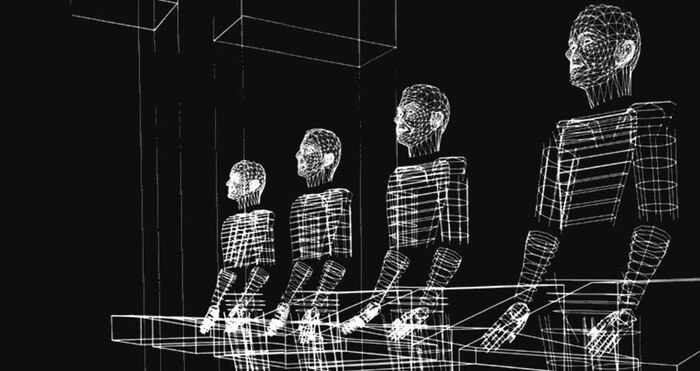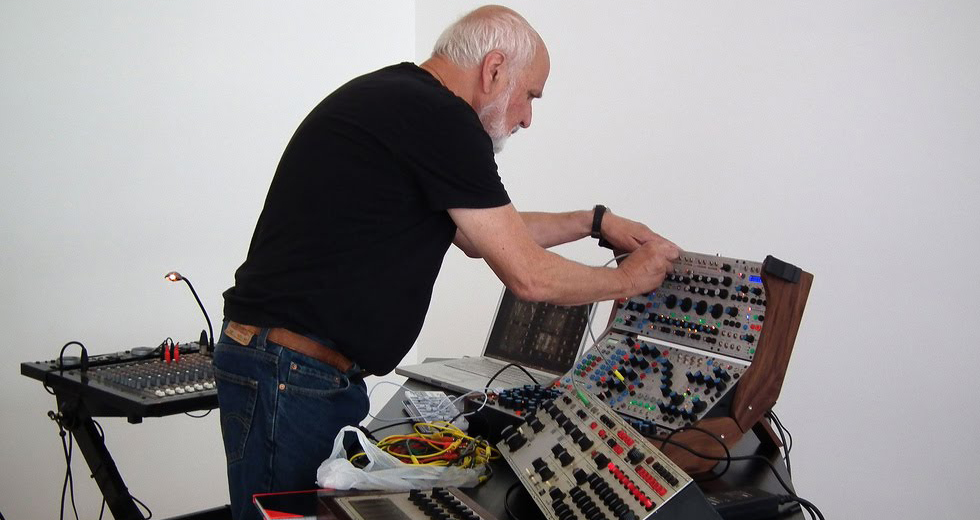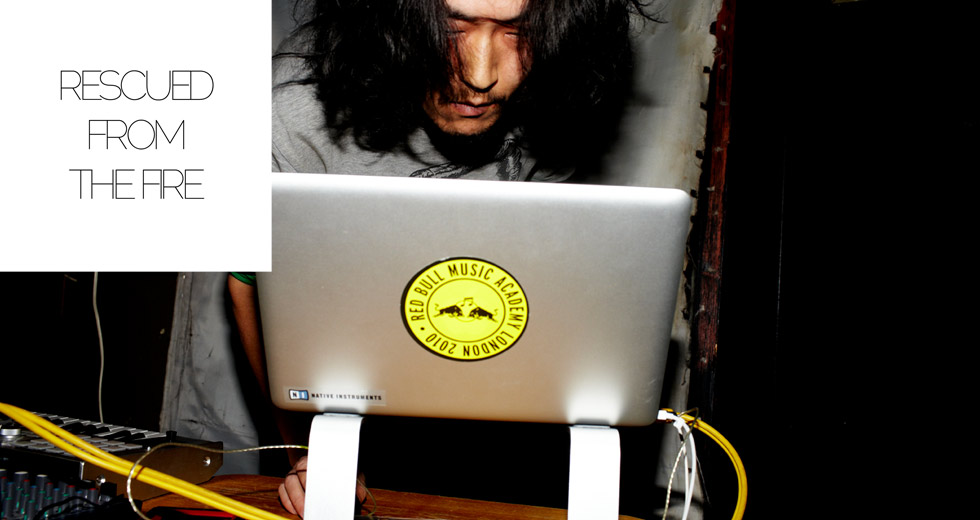Musikarbeiter: Live Electronic Performance Examined

Recently, Deadmau5 caused a virtual skirmish by confessing on his blog that his and others’ shows were predetermined affairs. Because it’s all about consistency and the visual spectacle, for him predictability is a virtue. Premixed tracks unfold according to a strict timeline, ensuring the music is familiar – right down to the sound balance, compression and so on – and that lighting can be cued up in advance. It was remarked (in some cases angrily) that he was speaking for a minority; nonetheless it raises questions about what our expectations are. In a good performance, what should be the relationship between improvising and representing existing work? How do we want what we hear to relate to what we see? Unsurprisingly, there are no concrete answers; rather, artists have been making up rules as they go along.
Originally the tools of electronic dance music were useful gadgets, descendants of the food processor. In the early 1980s, Roland’s publicity asked: why bother with bassists or drummers, when little silver boxes would produce for you a “totally programmable musical performance”? As we now know, they would be put to more significant use than had ever been imagined. Frankie Knuckles identified house as disco’s revenge, but house was revenge on disco, replacing session orchestras and recording engineers with consumer electronics. Disco’s unit of currency was the 12", and few audiences had ever been so detached from the experience of music as physical labour. Presumably, nobody worried about whether a microchip-controlled sequence of notes could meaningfully be ‘played live’, any more than they worried whether the Salsoul Orchestra would fit in a nightclub.
Fast-forward to the present day, and artists acknowledge that if they want to quit the day job, their only choice is to gig. This would explain the number who double as DJs without having any aptitude for it, while others attempt to translate studio practice onstage. Then there are megastars such as Deadmau5: although they’re less likely to struggle with paying the bills, the pop-cultural momentum of their music begs to be fed with arena concerts. It’s a good time to look past the DJs at a parallel thread in history, following what happens when producers step out in front of audiences.
Performing electronic music is a relatively old idea – and dancing to live music an older one, of course. As a live electronic group you could plausibly dance to, Kraftwerk provide a founding example of the two together – aptly enough, given their influence on techno and music in general. In the BBC documentary Krautrock: The Rebirth of Germany, Wolfgang Flür remembers touring after 1974’s Autobahn: at the time, Kraftwerk live consisted of Ralf Hütter and Florian Schneider on keyboards, with Flür and Karl Bartos hitting homemade electronic percussion. Later, with the musical and conceptual advances of The Man Machine, custom-built sequencing equipment was introduced to store, repeat and transmit musical information. For 1981’s Computer World tour, their Kling Klang studio became a travelling set up that could be dismantled or rebuilt in a couple of hours. The Musikarbeiter (Ralf and Florian began calling themselves ‘music workers’ about this time) were industrialising in line with their hi-tech image, so that old-fashioned musical toil was no longer a necessity, freeing themselves to improvise with patterns and structures.
In Detroit, by all accounts, Kraftwerk were more popular than disco, although disco DJs did inspire a general uptake in mixing. According to various interviews with Juan Atkins, Kevin Saunderson and others, a hybrid form of performance then began to catch on. Every DJ wanted a secret weapon, customarily an import or other rarity. Feeling that the pool was limited, Juan Atkins had another idea: during a contest with a rival crew he and Derrick May fired up a drum machine, sending the crowd wild. When May sold his Roland TR-909 to Frankie Knuckles, the craze spread to Chicago where the likes of Jesse Saunders created ‘beat tracks’, giving birth to house as a genre in its own right.
May’s 1989 gig at London’s Town & Country Club came closer to a Kraftwerkian scope, as recently surfaced footage shows. It shows a rearranged, part improvised rendition of “Strings Of Life”: assisted by a young Carl Craig, May triggers parts preloaded on sequencers while soloing across a bank of keyboards. In the context of late 80s Techno, it has the air of an experiment. How would May have expected the audience to respond, more used to interpreting his music through the filter of 12"s and DJs? The clip is dominated by his apparent earnestness, a determination to carve something out of the moment artistically worthwhile in its own right.
To draw a line from here to Deadmau5, you have to detour via the UK, where electronic dance music was first commercialised, packaged as rave culture. The phenomenon didn’t take hold in the US (or Deadmau5’s native Canada) until it was exported back. Perhaps inevitably, the original UK rave boom turned towards spectacle. Compared to the looser, less hierarchical synergy between DJs and crowds, acts such as The Prodigy and Orbital offered more conventional entertainment. Not coincidentally, they emerged with lengthy careers, transcending a faceless (though often superior) mass of names and 12"s.
“Unlike most rave acts, The Prodigy play live,” a title announces in an early TV interview, most likely from 1992. Liam Howlett (the group’s sole musical force) demonstrates how tracks can be rebuilt from fragments loaded into samplers, although he admits it’s impossible to play “totally live”. “I’d need probably about five people operating all the equipment,” he explains. “But we try to play as live as we can... the idea is just to get the buzz across to the crowd.” Crucial to this task is his cohort of MCs and dancers, cavorting around, and exhorting the ravers in between ‘trippy’ decor and a laser show. In a later interview (with Sound On Sound in 1996) Howlett implicitly acknowledges the root of The Prodigy’s success: “Our music is music to perform live to; when I’m writing, that’s what I’m thinking about every time. When people think of the band The Prodigy, they don’t think of me in the studio, they think of the whole thing on stage.”
Orbital sealed their credentials in 1994 by headlining the second stage at Glastonbury. Coming off like cyberpunk Keith Emersons behind a lorryload of equipment, the pair became known for the epic flow of their sets, directed spontaneously and evolving between gigs. In more than one sense, they were staging a full-scale occupation of rock’s arena.
They would later be outdone by the real masters of this strategy, Daft Punk, whose clout as a live act now matches that of stadium veterans. In 1997 Daft Punk took their home studio on the road to promote their debut album Homework. Much like a rock band would tour ahead of a release, they travelled between clubs across Europe and the USA – except they toted a tangle of old-school drum machines, synths and samplers. Recorded on the Birmingham, UK leg, Alive 1997 testifies to some artistic success: elements of Homework are strung out, tweaked and slammed together in rough and ready fashion, suiting the material better than the tamer arrangements on that album. These days the French duo perform ensconced in their iconic pyramid. Wearing robot costumes designed by Hedi Slimane, they interface with computers through cutting-edge touchscreen devices. It could almost be a deliberate answer to Kraftwerk’s post-human musical theatre, only rooted in 21st century consumer culture.
While it’s no surprise to see large-scale shows characterised by razzle-dazzle, this masks the real, consistent theme of the past three decades or so. Slowly at first, performers have creatively embraced modern dance music’s defining aspects: automation and repetition. Used productively, there’s no need to disguise or compensate for these fundamentals, as two current acts prove.
Robert Henke’s strengths lie in his dual identity: as well as a musician he’s an engineer, in literal and figurative senses. Although his Monolake project assembles components from dance music (particularly techno) his real focus is on sound’s inner mechanics. Preferably experienced though a six-channel soundsystem, his performances conjure an exploded view of electronic music, blowing it apart like schematics. Beats give the impression of shattering in mid-air and sounds circulate around the room, collapsing into bouncing particles. Henke hones his techniques partly through consulting in the development of Ableton Live, software intended for performance. In contrast to the timeline layout of other programs, Ableton runs on the fly, accommodating open-ended sequencing. He has reported that the first version was met with scepticism in 2001: when shown to software companies, they thought the idea of a laptop on stage was “crazy”. In fact, on stage Henke barely touches the computer. Instead he manipulates a control panel of his own design, providing him with a tactile interface with multiple software instruments and effects. Admittedly, detailed investigations into sound aren’t considered an exotic hobby in the world of ‘computer music’. Nor is sonic exploration unknown to dance music, even if it’s usually something simpler like sweeping the cutoff frequency of a filter. But Henke finds alternative meanings in both, as he synthesises the two disciplines.
Henke’s hands-on involvement with technology enables him to perform the way he wants, but it’s by no means the only way to do it. By contrast, Ralph Cumbers manages to exploit a lo-fi approach to the same end. As Bass Clef he prefers to jam with analogue hardware, touching on outsider interpretations of dubstep and Chicago acid as he goes. In a sense he ‘versions’ his recordings dub reggae-style, sometimes including live trombone on top. Answering questions about his set-up via email, he also lists a drum machine, a sampler, guitar effects pedals, hand percussion and whistles, “all fed into a mixing desk and dubbed out, looped and rearranged.” At times he adds layers from a backing CD, but only sporadically. For him, live performance complements the recording process: “The way I record my tracks is by doing live takes to tape, so they feed into each other. But everything is different when there’s an audience. I never rehearse for example. It’s the danger element, the improvisation that keeps live sets fresh for me.”
DJs still cast a long shadow over dance music, remaining in place as its chief interpreters. But in reality they have never had a monopoly: the best live acts make just as much sense. As the latter multiply we’ll be forced to accept this. For every Deadmau5 out there, there’s a performer capable of rivalling the best DJs – and of making the mediocre ones seem irrelevant.
“Playing live is magical,” Cumbers says. “I think of it as a totally separate discipline from writing/recording – it’s about creating a moment, or a space, where the normal rules of life don’t apply, a flow of energy back and forth between you and the crowd, trying to making something happen that has never happened before.”

